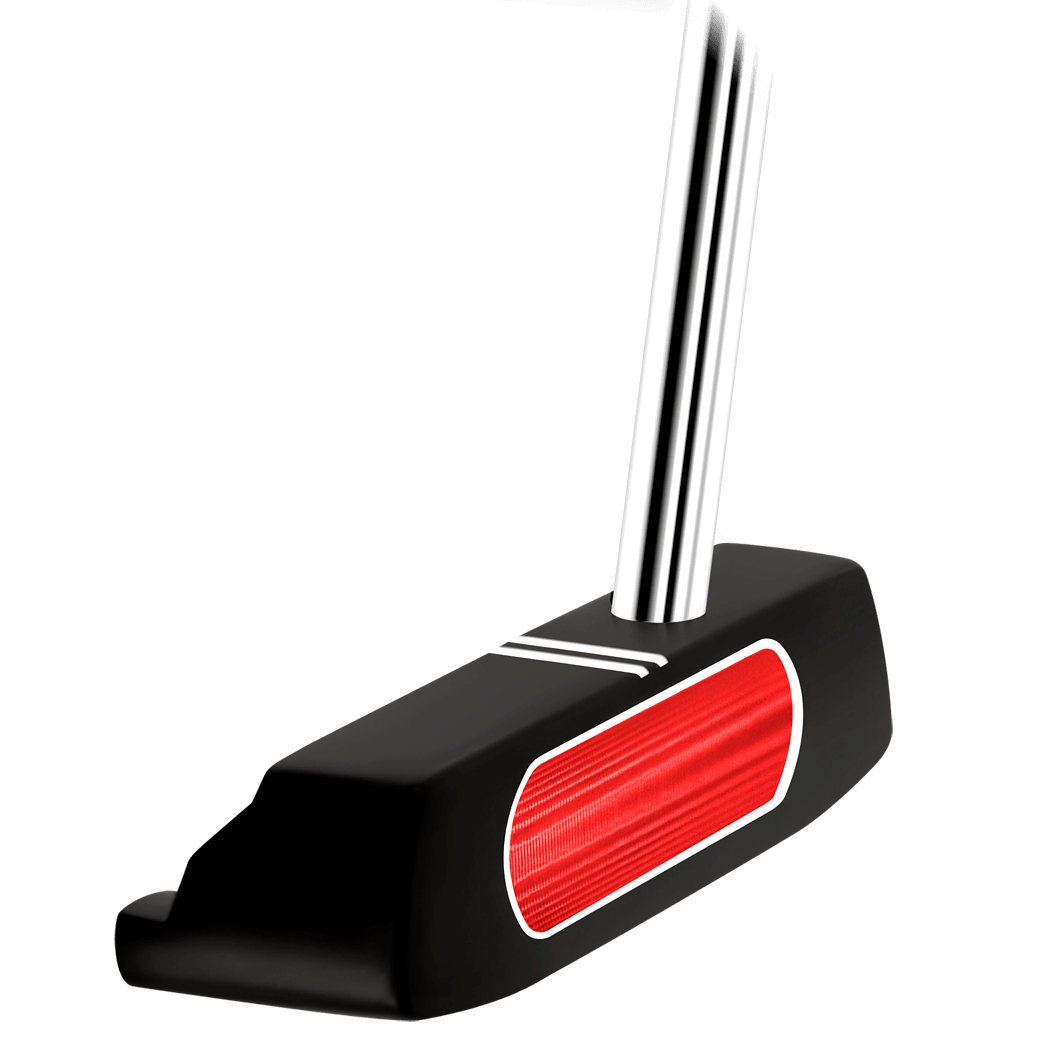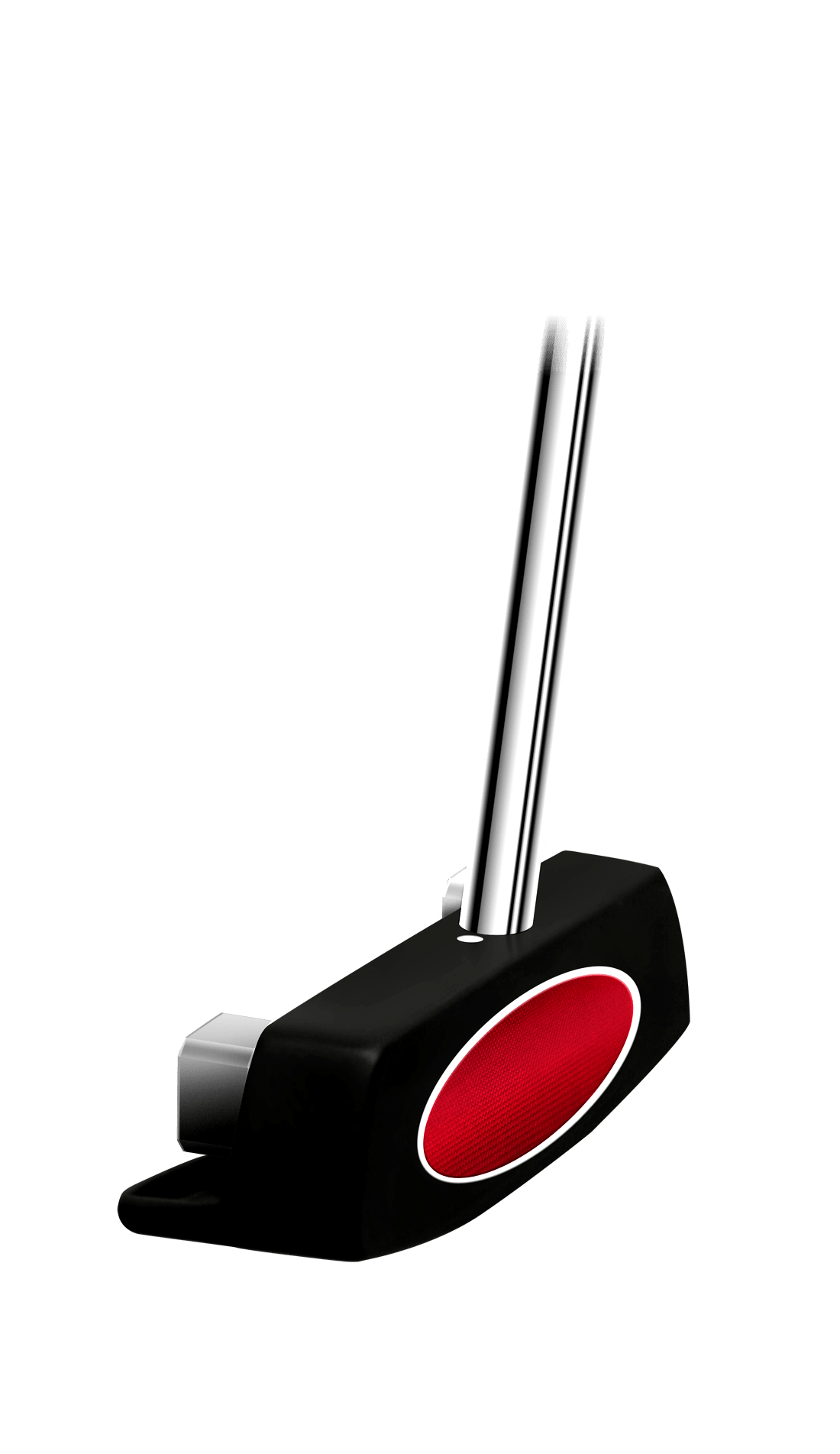
An over the top golf swing is experienced during your downswing.
As you swing the golf club back down towards the golf ball, if you look at your swing from the side you would see that the club head moves over the top of your hands and towards the target line. The result of this movement is that the club head will now move to the far side, or to the outside of the target line and for you to hit the golf ball from this position you will now need to pull the club head towards you and across the target line to the inside of it, or the side that you are standing on.
This movement is caused by rotating your upper body to initiate your downswing rather than rotating your lower body first. As you turn your shoulders towards the target, the club is thrown forward and over your hands and it becomes very difficult to hit straight golf shots at the target.
To correct this movement and to improve your accuracy with hitting golf shots at the target, work on the following golf drill. Set up ready to hit your golf shot and then place a range basket about one foot to the right of the golf ball, if you are a right handed golfer, and about two inches on the far side of the target line. You should be able to swing your golf club away from the ball without hitting the basket but the club head should only just move inside the basket.
On your downswing, work on turning your lower body towards the target first, Turn your knees then your hips and then finally your upper body and shoulders towards the target and swing the golf club down on the inside of the basket to strike the golf ball. Do this slowly at first and as you become better with the movement gradually build the speed back into your swing but make sure that you keep the club head on the inside of the range basket as you approach the golf ball.
Working on doing this will get you swinging the club head from along the target line and will prevent you from making the over the top movement, which would result in the club head striking the range basket. With the club head moving along the target line if you keep the club face aiming at the target as you do this, you will begin hitting straight golf shots which will really improve your accuracy the next time you are out on the golf course.
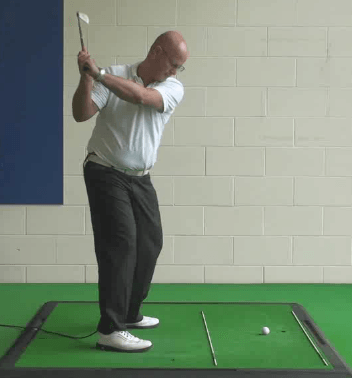
What is an Over-the-Top Golf Swing and How Can I Cure It?
Even if you only have a little bit of experience in the game of golf, you are probably familiar with the term 'over-the-top' in reference to the golf swing. This phrase is often tossed around on the driving range, even if some golfers don't know exactly what it means. Unfortunately, the over-the-top swing is a problem for countless amateurs, so it is something which is certainly worth solving if at all possible. If you are currently dealing with an over-the-top move in your swing, correcting that error should be your top golf priority.
Although making an over-the-top swing can actually be associated with a number of different ball flight problems, it is associated mainly with one serious issue – the slice. Those who swing the club over-the-top usually fight a slice, which just so happens to be the most common ball flight error in the amateur game. If you have a slice, there is a good chance that you are taking the club over-the-top during your swing. Until you get rid of that costly over-the-top move, you won't be able to wipe out your slice once and for all.
In this article, we are going to address this problem head on. We are going to explain exactly what it means to take the club over-the-top, and we are going to offer some advice on how you can fix this error. Make no mistake – this is not going to be easy. It is certainly possible to take the over-the-top move out of your swing, but doing so is going to require some significant effort and attention to detail. It won't happen just by walking out to the range and hoping for the best. You are going to need to have a very specific plan in mind, and you are then going to need to execute that plan perfectly. In the end, your hard work will be rewarded when you see your slice disappear once and for all.
As you may already know, playing golf with a slice is no fun at all. The slice has frustrated millions of golfers throughout the history of this game, and it continues to bother countless players to this day. In fact, some golfers have even given up altogether because they were unable to shake the slice. There is more to golf than just shooting low scores, but it is certainly hard to have fun on the links when every single shot slices off in the same direction. Rather than letting this pattern frustrate you to the point of giving in, you should instead look for practical, logical solutions. Learn as much as you can about your technique, what is going wrong, and how it can be corrected. By taking a level-headed approach to this issue, you should be able to get back on track in the relatively near future.
All of the content below is based on a right-handed golfer. If you happen to play left-handed, please take a moment to reverse the directions as necessary.
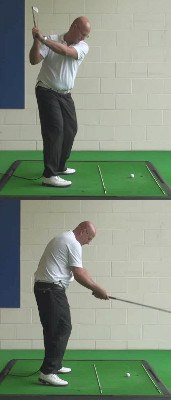
Defining an Over-the-Top Swing
Anytime you set out to fix a problem in your golf swing, the first thing you need to do is understand that problem as completely as possible. In fact, that statement applies to anything in life. If you have a problem, you need to understand the problem before taking action. Trying to solve a problem you don't even understand could lead to some pretty disappointing outcomes.
In the case of an over-the-top swing, you might not exactly understand what we are talking about here. Sure, the words 'over-the-top' do some of the explaining, but not all of it. What does it mean to swing over-the-top? This term comes from the action the club takes during the transition from backswing to downswing. When the club gets to the top of the swing, it should ideally drop down into the slot and fire toward the ball from the inside. This is how you create a powerful strike which sends the ball in the direction of the target more often than not.
If you are swinging over-the-top, however, you are not making this move correctly. Instead of letting the club drop to the inside, you are pushing it up and 'over top' of the ideal swing path. Your hands and the club get higher during the transition, instead of lower, and you are immediately in trouble. An over-the-top swing usually leads to a slice because of the path that is created by the faulty transition. With the club and the hands too high, you will have no choice other than to swing across the ball at impact. In the end, side spin will be the result and the shot will curve wildly from left to right.
This is a difficult problem to correct because to most golfers, this move feels perfectly natural. If you have always been swinging the club in an over-the-top manner, nothing feels wrong during the transition. You think that this is how the club should be swung, and it must be some other problem that is leading to the slice. Most players never get down to the point of fixing the transition to remove the over-the-top action, and as a result, most players never get rid of the slice.
There is no way around it – if you want to take the slice out of your game once and for all, you will need to get rid of your over-the-top move. That is going to be a challenge, and you will need to have plenty of patience and dedication to do so successfully. Many golfers have set out on the road to eliminating the over-the-top swing, and many have given up before succeeding. There are certainly plenty of golfers who have come out on the other side, and you should use that fact as motivation, but don't go into this process thinking that it will be easy.
One of the things you can do to gain a better understanding of over-the-top swings is to watch some of them for yourself. Instead of just feeling this move in your own swing, watch other golfers who struggle with the slice. Most likely, it won't be hard to find one. In fact, there is probably at least one other player among your group of golf buddies who has the same problem you do. Watch that player swing the club and see if you can spot the over-the-top action during the transition. By seeing it from this perspective, it is going to be much easier to understand how you need to correct the error in your own technique.

Building a Platform for Success
Here is one of the trickiest things about getting rid of an over-the-top swing – you actually have to work back through your swing even before the transition to make the correction. For most players, the problem which occurs in the transition is actually a symptom of an even earlier mistake. If you arrive at the top out of position, it won't matter how much you try to pull the club down to the inside – it just isn't going to happen.
To actually cure your slice once and for all, you need to work all the way back down to the beginning of your swing. The tips below highlight a few of the key points you should follow in order to build a platform for a slice-free swing.
- A square stance. Many players go wrong right from the very beginning in the golf swing. Instead of setting up square to the target line, players who fight a slice usually have at least one part of the body out of alignment. Often, it is the shoulders which are open to the line. This sets a back precedent, as your shoulders are getting comfortable in an open position – which makes them more likely to return to that open position at impact. You want your address position to largely mirror your impact position, so do your best to set everything square to the line before starting your swing. Pick a very specific target for the shot, square up your feet, knees, and shoulders, and then initiate the takeaway.
- A flat back. When a golf pro watches an amateur tee off, he or she can often predict the presence of a slice just by watching the player address the ball. The big giveaway in this case is when the player hunches over the ball rather than using a flat back at address. When you hunch, you are leaning out over the ball and putting yourself off balance from the start. When the swing begins, the club will likely move to the inside of the line to compensate for the fact that you are leaning out too far. With the club inside, you will be crowded when you arrive at the top, and the only choice will be to push the club up and away from your body before the downswing begins. By simply improving your posture and flattening your back, you can potentially correct this entire series of events.
- Chin up at address. This is one of the biggest fundamental keys in the game of golf, yet most players have never been given this point of instruction. When you stand over the ball, your chin should be up away from your chest while your eyes look down at the ball. Since you have probably been told that you need to keep your eyes on the ball, you may force your chin down so you can get a good look. You might see the ball better this way, but keeping your chin down will cause trouble because the chin is going to get in the way of your shoulder rotation. This could lead to a short backswing, and an over-the-top move. No matter what club you happen to be holding, make sure your chin is up away from your chest before the swing starts. It is amazing how something so subtle and basic can have such a powerful impact on the results of your swings.
The solutions to your golf problems can often be found in the basics. Even with something like the slice – which is a long-lasting, extremely frustrating problem – the answer is probably sitting there in front of you, hidden in the basics of your technique. Take the time necessary to learn how to build a proper stance and you will be a big step closer to a slice-free game. Even if you aren't at the range and don't have your clubs around, you can still take practice stances in front of a mirror to work on your mechanics. With a reliable stance on your side, this difficult game will get a lot easier.
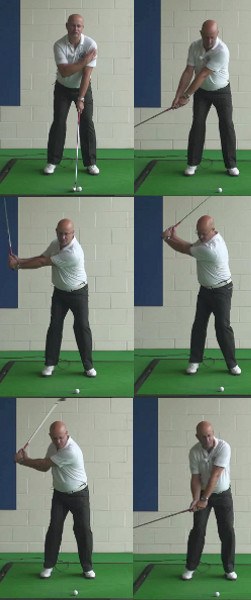
It's All About the Takeaway
If you want to cure your slice, you have to fix your takeaway. We can't say it any clearer than that. The takeaway is an often-overlooked part of the golf swing, but it shouldn't stay that way in your game. Getting the takeaway right is one of the most important things you can do, as it sets you up on a path for success. Without a good takeaway, you will always be playing catch-up with your swing – and most golfers never do manage to catch-up. They are out of position right from the start and they stay that way until the ball is sent off into the distance going the wrong direction.
The big mistake you need to avoid with the takeaway is bringing the club back too far to the inside. This is easily the most common error among amateur golfers, and it is the one which leads to an over-the-top transition. We touched on this concept above, but let's get into it a little further here to make sure you understand what is going on.
- When the club starts to move back away from the ball, the first foot or so of the backswing is known as the takeaway. A straight takeaway would be one which traces an extension of the target line as it runs through the ball and away from the target you have picked for the shot.
- If you are a slicer, you almost certainly move the club inside this line on the way back. Usually, this happens because the hands are too active in the early stages of the swing. The right hand pulls the club back, the right wrist hinges, and the club head swings to the inside. This subtle, silent move can single-handedly kill your entire golf swing.
- With the club stuck to the inside, your backswing will continue in a narrow manner. You will have forced your arms in close to your body as a result of the poor takeaway, so you will be crowded and you won't have the extension needed to build power. Then, at the top, you will be forced to go over-the-top due to a lack of room in by your body. Those with a wider backswing can drop the club into the slot during the transition, but you aren't going to have that choice. Instead, the club will have to move up and away, and swinging across at impact will be your only option.
This is a nasty cycle, and it is one which is hard to break – especially if you don't understand that the takeaway is the root cause. Now that you know your takeaway is likely to blame, you can get to work on fixing that faulty element. Many golfers are stunned to find that simply fixing the takeaway can remove most of the slice from their game.
One simple way to make a better takeaway is to take your right hand off the club and practice some backswings with your left hand only. This will prevent your right hand from being too active early in the swing, since it will be in your pocket rather than on the club. With no reason to worry about the right hand interfering, you can let your shoulders do most of the work when the swing begins. This is how it should be, even when two hands are on the grip. The shoulders do the work of turning away from the target, and the hands go along for the ride.
Once you have practiced some simple one-handed takeaways, put your right hand back and hit some chip shots. By shortening the swing, it will be easy to focus on your takeaway without thinking about the rest of the action. Give yourself some time to work on the takeaway while chipping before ramping all the way back up to a full swing. In the end, you should be able to make a better takeaway without any trouble, and your ball flight should suddenly be much straighter.

The Rushing Problem
Most golfers who swing over-the-top do so because they have a technical flaw in their swing. That is not always the case, however. It is possible for an over-the-top swing to be the result of a mental mistake. Rather than giving yourself enough time to properly complete the swing, you may rush through the action and force yourself to get it over with as quickly as possible. When that happens, the club could go over-the-top as a shortcut to get down to the ball immediately. The results are ugly – not only could you hit a slice, but you might miss-hit the shot entirely.
So how do you stay away from making a rushed swing on the course? Use the tips below.
- Don't let others rush you. It is common for golfers to feel rushed by other players on the course. Maybe it is someone in your group who is constantly walking up in front of you, or maybe it is the group behind staying right up next to you all day long. Whatever the case, you need to have the self-confidence to stick to your routine even in the face of this kind of pressure. That doesn't mean you have a license to play slow – it is every golfer's responsibility to keep the pace of play moving. However, you don't have to rush, and you should be able to settle into a nice rhythm which allows for quality swings.
- Take a deep breath. One of the most powerful things you can add to your golf technique is a simple deep breath. By taking a deep breath in and out before you walk up to the ball and take your stance, you can relax both your body and mind. In the process of picking a club and thinking about your strategy for a given shot, you might forget to slow yourself down and focus on the task of making a smooth swing. This is where the deep breath comes in handy. It will require you to slow down, even if only for a moment, and it may even help to relax some of your nerves.
- Visualize success. If you are only thinking about the many ways in which your shot can go wrong, it will be easy to rush as your nerves will get the best of you. Instead of expecting failure, picture a great shot and then work on bringing that picture to life. See yourself making a smooth swing, sending the ball high into the air, and bringing it down softly right next to the target. You aren't always going to be able to match that picture, but many golfers are surprised to learn how powerful a good visualization routine can be.
It is no fun to play golf with an over-the-top swing. You might still find ways to enjoy your time on the course, but you will probably be frustrated for most of the day. We hope the advice in this article will help you to take some of the slice out of your game. Golf is simply a lot more fun to play when you can keep the ball in the fairway more often than not. Good luck!






